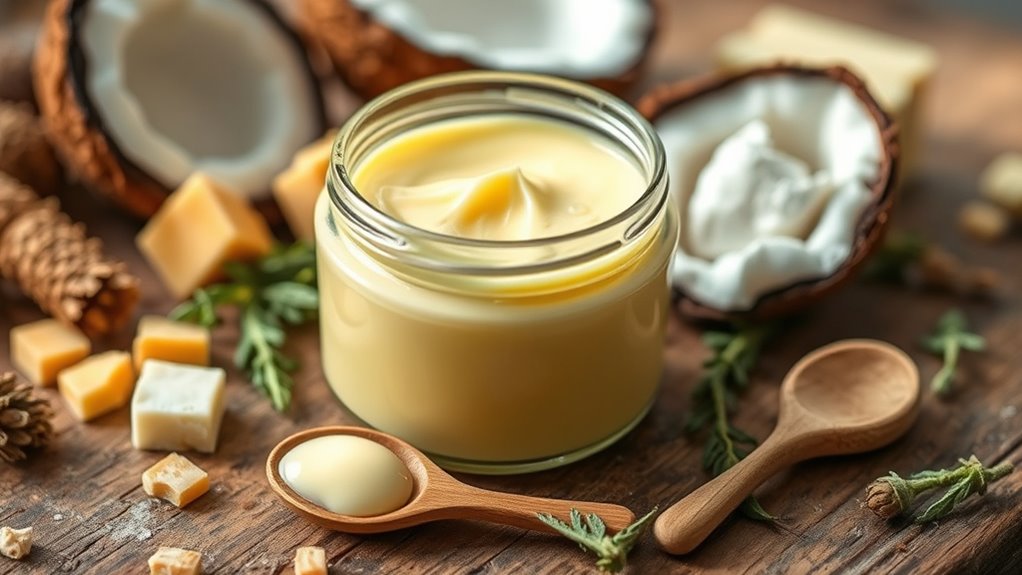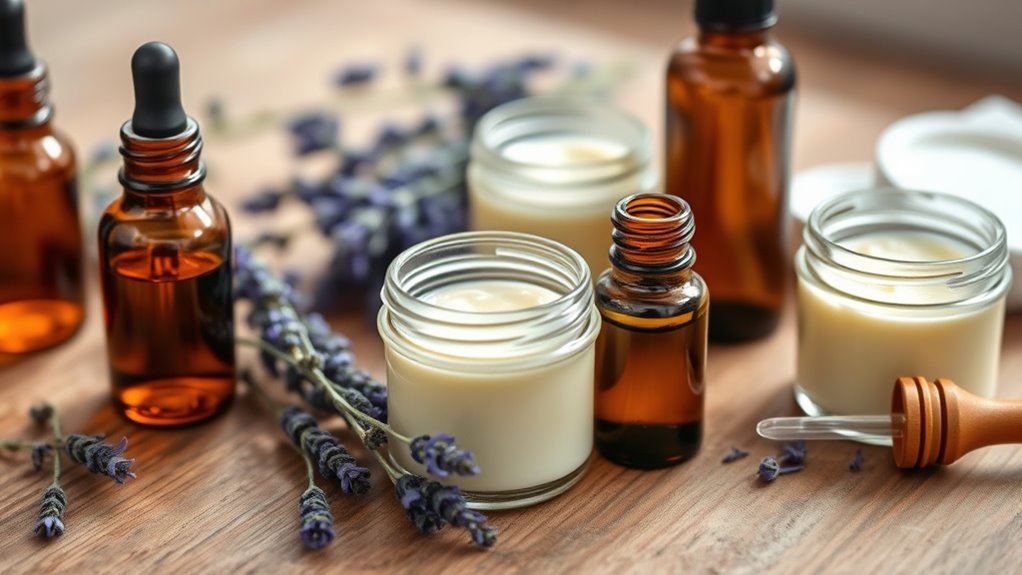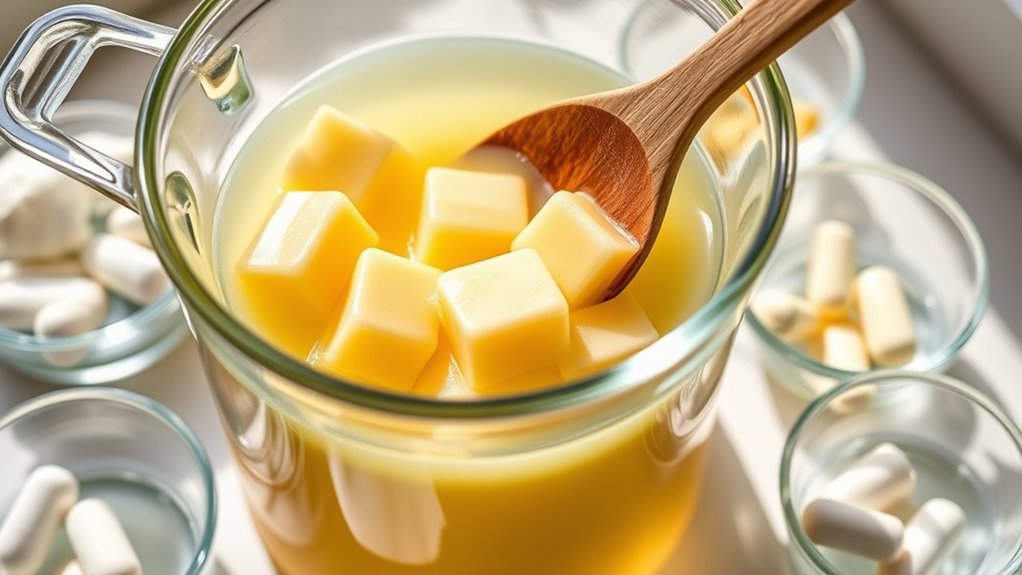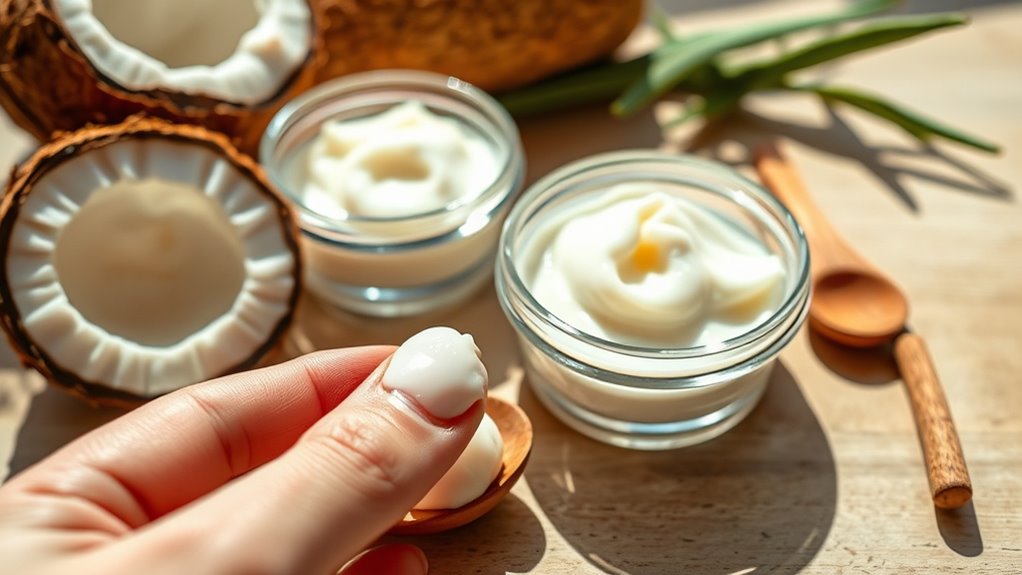To make a DIY anti-chafe balm for sensitive skin, choose gentle oils like shea butter, coconut, or jojoba, and incorporate calming herbs such as chamomile or lavender. Melt these ingredients carefully using a double boiler, add natural preservatives, and optionally include small amounts of soothing essential oils. Properly package and store the balm in cool, dark places to extend its shelf life. If you want to learn more, you’ll find easy tips to customize and apply the perfect homemade balm.
Key Takeaways
- Use gentle, soothing ingredients like shea butter, coconut oil, jojoba, and herbal infusions to minimize skin irritation.
- Incorporate natural preservatives such as vitamin E or rosemary extract to ensure product freshness and safety.
- Add small amounts of calming essential oils (lavender, chamomile) to enhance soothing properties without causing irritation.
- Melt ingredients gently using a double boiler, maintaining proper temperature control to preserve their beneficial qualities.
- Package in airtight, leak-proof containers, store in cool, dark places, and regularly check for signs of spoilage to extend shelf life.
Choosing the Right Natural Oils and Butters

When choosing natural oils and butters for your anti-chafe balm, it’s important to select those that are moisturizing, lightweight, and absorb quickly into the skin. Herbal infusions can add soothing, skin-calming properties, making your balm more effective. Carrier oils like jojoba, sweet almond, or grapeseed are excellent choices because they’re gentle and easily absorbed, reducing the risk of clogged pores. Look for oils that provide hydration without feeling greasy or heavy. Using herbal infusions in your carrier oils enhances the balm’s healing qualities, especially for sensitive skin. Incorporating knowledge about pregnancy can help tailor your ingredients to support skin health and comfort during sensitive times. Additionally, understanding projector technology can inspire creative DIY solutions for personalized skincare packaging. Awareness of skin sensitivities ensures your balm is gentle and suitable for delicate skin, making it a more effective and soothing product. Exploring natural preservatives can also help extend the shelf life of your homemade balm without compromising its gentle properties. Together, these ingredients create a nourishing, non-greasy base perfect for a comfortable anti-chafe product.
Basic DIY Anti-Chafe Balm Recipe

Creating your own anti-chafe balm starts with choosing the right ingredients and understanding their benefits. Next, follow clear steps to melt and mix your components smoothly. Once made, learn how to store it properly and apply it effectively for lasting comfort. Incorporating natural ingredients like beeswax and carrier oils can enhance the safety and effectiveness of your balm, especially for sensitive skin. Using proper formulation techniques can also prevent issues like separation or spoilage, ensuring your balm remains safe to use over time. Additionally, maintaining proper storage conditions can extend the shelf life of your homemade balm and preserve its qualities. Being aware of skin sensitivities can help you select ingredients that are less likely to cause irritation, making your balm even more suitable for sensitive skin.
Ingredient Selection Tips
Choosing the right ingredients is essential for making an effective anti-chafe balm. Focus on gentle, skin-soothing options that suit sensitive skin. Use natural preservatives to extend shelf life without harsh chemicals. For fragrance alternatives, opt for scent-free or natural essential oils if tolerated. Incorporate trusted ingredients known for their safety and efficacy in sensitive skin formulations. Incorporating ingredients with proven safety profiles ensures your balm is both effective and gentle on sensitive skin. Here’s a quick guide:
| Ingredient Type | Tips | Examples |
|---|---|---|
| Base oils | Choose nourishing, non-irritating | Coconut, shea butter |
| Natural preservatives | Use antioxidants to prevent spoilage | Vitamin E, rosemary extract |
| Fragrance options | Avoid synthetic fragrances | Unscented, lavender, chamomile |
Selecting these ingredients carefully guarantees your balm is safe, effective, and personalized to your sensitive skin needs.
Step-by-Step Preparation
To make your own anti-chafe balm, start by gathering all necessary ingredients and equipment, including a double boiler or a heat-safe bowl and a spoon. Begin melting the base oils and beeswax, stirring gently until smooth. As you work, focus on achieving the desired balm consistency—more beeswax for firmness, more oil for softness. Proper ingredient sourcing guarantees quality and safety, especially for sensitive skin. Once melted, remove from heat and add optional soothing agents like shea butter or essential oils, stirring thoroughly. Pour the mixture into a clean container and let it cool to solidify. For a refined texture, you may strain the mixture before pouring. This process guarantees a smooth, easy-to-apply balm with suitable consistency for chafing relief.
Storage and Usage
Once you’ve prepared your anti-chafe balm, proper storage guarantees it stays effective and safe to use. Keep the balm in a cool, dry place away from direct sunlight to prevent melting or spoilage. If you prefer, use eco-friendly packaging like glass jars or aluminum tins, which are reusable and sustainable. If beeswax isn’t suitable, explore beeswax alternatives like candelilla or carnauba wax, which work well in balm recipes and are often more environmentally friendly. Always label your containers clearly and ensure they’re tightly sealed to prevent contamination. When applying, use clean fingers or a spatula to avoid introducing bacteria. Store your balm out of reach of children, and replace it if you notice any changes in smell, texture, or color.
Customizing Your Balm for Sensitive Skin

When customizing your anti-chafe balm for sensitive skin, it’s vital to select gentle, soothing ingredients that minimize irritation. Focus on natural, hypoallergenic options like shea butter, coconut oil, and beeswax to guarantee comfort. For fragrance customization, opt for subtle, fragrance-free bases or gentle natural extracts that won’t overstimulate your skin. Consider packaging options that protect your balm from contamination and exposure, such as metal tins or air-tight jars. This not only preserves the balm’s integrity but also allows for easy application on sensitive areas. To elevate your product’s presentation, choose minimalist, eco-friendly containers. Remember, simplicity and skin-friendly ingredients make a significant difference in creating a balm that’s both effective and gentle for sensitive skin.
Adding Essential Oils for Extra Comfort and Fragrance

Have you considered how adding essential oils can enhance both the comfort and scent of your anti-chafe balm? Essential oils offer aromatherapy benefits that can help you relax and feel refreshed with every use. When selecting oils, think about fragrance blending to create a calming or invigorating aroma tailored to your preference. Popular options like lavender, chamomile, or tea tree not only smell great but also have skin-soothing properties. A few drops go a long way, so start small and adjust to your liking. Properly incorporating essential oils ensures your balm smells wonderful while providing additional comfort. Just remember to choose oils suitable for sensitive skin to avoid irritation and maximize both aromatherapy benefits and fragrance appeal.
Tips for Properly Melting and Mixing Ingredients

To guarantee your anti-chafe balm has a smooth, uniform consistency, it’s important to melt and mix the ingredients carefully. Start by using gentle heat, maintaining proper temperature control to prevent overheating or separation. Use a double boiler or a heat-safe bowl over simmering water, avoiding direct heat. Incorporate emulsification techniques, stirring steadily to blend oils and waxes evenly. Keep the temperature consistent to ensure ingredients melt thoroughly without degrading sensitive components.
- Use a thermometer to monitor temperature precisely
- Stir continuously to promote even emulsification
- Avoid sudden temperature fluctuations to prevent separation
Packaging and Storage for Longevity

Proper packaging and storage are essential to keep your anti-chafe balm fresh and effective over time. Use clean, airtight containers, like small jars or travel containers, to prevent contamination and preserve your balm’s potency. Label each jar clearly with jar labels that include the date you made the balm, so you can track its freshness. If you plan to take your balm on the go, opt for travel containers that are leak-proof and TSA-compliant. Store your balm in a cool, dark place away from direct sunlight and heat, which can degrade ingredients. Avoid frequent opening to maintain its consistency and prevent contamination. Proper packaging and storage not only extend the shelf life but also ensure your homemade anti-chafe balm remains safe and effective whenever you need it.
Applying Your Homemade Balm Effectively

Applying your homemade anti-chafe balm effectively guarantees maximum comfort and protection. To achieve this, focus on proper application techniques and consistent frequency of use. Before applying, verify your skin is clean and dry. Use your fingertips or a spatula to gently spread a thin layer over areas prone to chafing. For best results, reapply after sweating, showering, or every few hours during active days. Consider these application tips:
Ensure clean, dry skin and reapply frequently for maximum anti-chafe protection.
- Use a gentle, circular motion to evenly distribute the balm.
- Apply a thin, even layer to avoid excess buildup.
- Reapply as needed, especially during prolonged activity or exposure to moisture.
Frequently Asked Questions
How Long Does Homemade Anti-Chafe Balm Typically Last?
Homemade anti-chafe balm usually lasts about 3 to 6 months, depending on how you store it. Proper storage duration is key to maintaining ingredient preservation and preventing spoilage. Keep it in a cool, dry place away from sunlight, and always use clean hands or tools to apply. If you notice a change in scent, texture, or color, it’s best to discard it to ensure safety and effectiveness.
Can I Use This Balm on Other Sensitive Skin Areas?
Imagine your skin as a delicate garden—tender and needing gentle care. You can often use homemade anti-chafe balm for multi-area application, but always test for skin compatibility first. Since it’s designed for sensitive skin, it’s likely safe on other areas, yet individual reactions vary. Apply a small amount, observe, and verify no irritation occurs before broader use. Your skin’s health deserves thoughtful, cautious care.
Are There Any Ingredients to Avoid for Allergic Reactions?
When choosing ingredients for your balm, you should be cautious of allergenic ingredients that could trigger reactions, especially with sensitive skin. Avoid common allergens like certain fragrances, dyes, and nuts. Also, consider preservative concerns, as some preservatives may cause irritation or allergic responses. Always patch-test new products and read ingredient labels carefully to guarantee you’re not exposing your skin to potential irritants.
How Often Should I Reapply the Balm During the Day?
You should reapply the balm based on your skin sensitivity and activity level, typically every 2-4 hours. If you notice increased chafing or discomfort, reapply sooner. Pay attention to how your skin reacts after each application, and adjust the application frequency accordingly. For sensitive skin, it’s better to reapply sparingly and avoid overdoing it, ensuring your skin stays protected without irritation.
Is It Safe to Use Homemade Balm Under Clothing?
Ever wondered if your homemade balm is safe under clothing? You can usually wear it safely, but check fabric compatibility to avoid staining or damage. Confirm ingredient safety by using gentle, non-irritating components. Test a small patch first, especially if you have sensitive skin. If the balm absorbs well and doesn’t stain your clothes, it’s likely safe to wear under your favorite fabrics all day long.
Conclusion
Creating your own anti-chafe balm is like crafting a tailored shield for your skin, protecting and soothing with every application. By choosing gentle oils, customizing ingredients, and mixing with care, you turn simple ingredients into a powerful ally against chafing. With proper storage and application, your homemade balm becomes a trusted companion on your journey to comfort. Embrace this DIY craft, and let your skin flourish like a well-tended garden—healthy, resilient, and full of life.









